Crapshoot: Game Over, the movie made of terrible leftover cutscenes
We're rerunning Richard Cobbett's classic Crapshoot column, in which he rolled the dice and took a chance on obscure games—both good and bad.
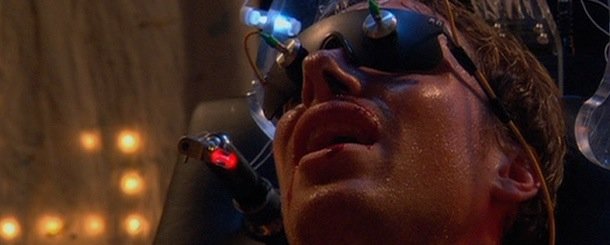
From 2010 to 2014 Richard Cobbett wrote Crapshoot, a column about bringing random obscure games back into the light. Remember when CD-ROM first came out and games desperately wanted to be movies? This is what happened when they finally got their wish.
Back in the 90s, the gaming industry collectively looked behind its sofa, found a forgotten carton of orange juice that had been sitting next to the radiator for a few years, and decided to see how it tasted. In the fermented insanity that followed, developers everywhere became convinced that the way forward for games wasn't to make them deeper or more exciting, but to make them into films. Interactive movies, if you will. The excitement lasted a couple of years. The hangover and regret never quite faded. Game Over is the obscene tattoo around the nipples of that whole sorry affair.
You know that old saying about not judging a book by its cover? Game Over is not a book.
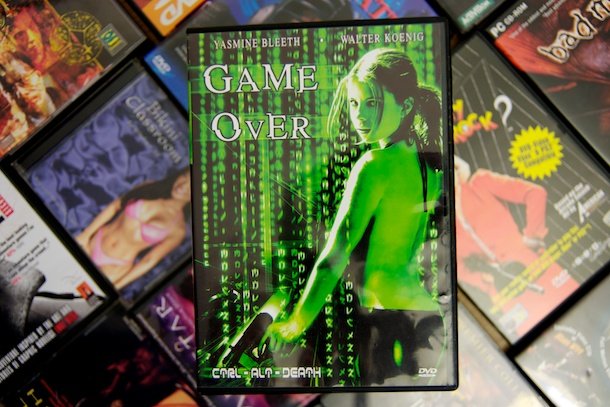
I won't spoil what makes this straight-to-video stinker so... unique... just yet. Instead, let's take a look at what it offers. First, the stars. Yes, Game Over has stars. Two of them. Walter Koenig and Yasmine Bleeth.
Its tagline is "CTRL-ALT-DEATH". For Special Features, it proudly promises "Spanish Subtitles. Stereo. Trailers" and even "Menus". The printing on the DVD case suggests it was knocked off on someone's home inkjet printer, with the main image being a blatant Matrix rip-off accompanied by a girl wearing a shiny outfit designed to give the illusion that she's topless without actually being so crude. Needless to say, she's not in the movie, although her hairstyle is, so that's something.
You'll note the lack of a rating on this one. This will soon cease to be a surprise. Game Over voluntarily gives itself a PG-13 though, due to containing, I quote, "VIOLENCE AND SOME DIALOGUE".
Oh no! Not dialogue! Anything but that! Think of the children!
The biggest gaming news, reviews and hardware deals
Keep up to date with the most important stories and the best deals, as picked by the PC Gamer team.
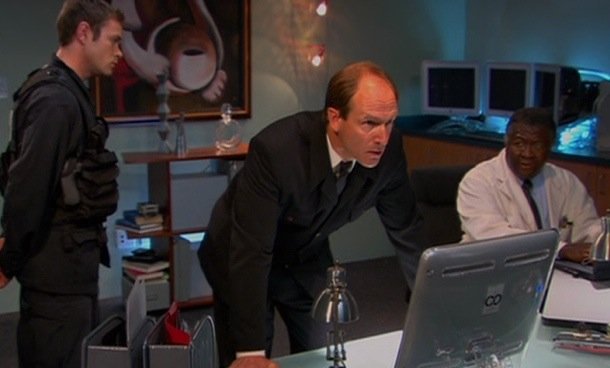
When you've seen as many bad movies as I have, you learn to spot the warning signs early. In the case of sci-fi movies, nothing screams "DANGER WILL ROBINSON" like seeing a movie with no budget try to compensate with bullshit. You know the kind of thing I mean. If you don't, the fact that the titles take the form of a wacky futuristic police report will quickly explain it. We're not watching a movie, you see. We're accessing NET POLICE FILE A1233922, because it's The Future and numbers are Sexy.
(I wonder what A1233921 was about. Probably the epic tale of a poor kid chased off a cliff by jackbooted stormtroopers for torrenting an episode of The Big Bang Theory. You'd think the fact that this is the story of the near-annihilation of humanity... sort of... would warrant a snappier file designation...)
Page after page of Future Bullshit follows, welcoming us to a world where the police prioritise a person's Tech Patents over their actual criminal records, yet still take surveillance photos with snappy, clicky cameras instead of something stealthy and futuristic, like a camera that doesn't go KACHUNK CHUNK every time the shutter fires. This sequence mostly serves to introduce us to our hero, Steve Hunter, who is about as interesting and charismatic as that name suggests. Much of the movie is spent watching him sitting in a Future Chair, just grunting and sweating a lot. You have been warned.
Before we're deemed ready to meet the man himself, we're introduced to his boss Elaine, talking to a therapist about his mental health. Seems Steve has been suffering from depression of late, not to mention antisocial behaviour—not least using a computer avatar of his face to call the office. The therapist asks Elaine if she'll lend her resources to an unusual form of therapy. "You have my full support and the full support of my staff," she tells him, which would be much more generous if her company—CyberCinema—didn't have a staff of precisely three. Including her and Steve. We're not told what the therapy is, but I don't think it spoils much to say that it ends up being of the "Cheer the hell up by defeating a megalomaniac AI in a fight to the death" school of treatment, as recommended by Freud, Jung, and the TriOptimum Corporation. Ask your therapist about it today!
And if you don't have a therapist, ask your doctor and you'll soon have one!
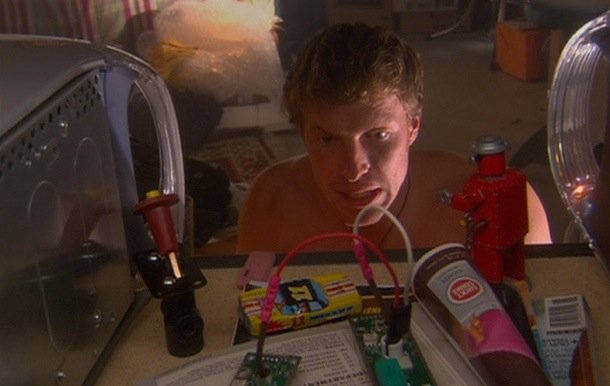
Such things have to wait though, as we cut to Steve's Futuristic Apartment of The Future, which happens to be littered with CRT screens and what are clearly old Macs, but only because The Future is on a bit of a retro kick. Well, not really. But I'm trying to be nice and work with it here.
Steve is woken up by a badly rendered CGI screensaver that informs him that the Death Toll is currently over 23,000 and rising. A copy of Genius Today magazine subtly hints that he's the inventor of a new warfare system, as well as being the world's greatest (cough) game designer. He groggily comes to from a pillow made of bubblewrap, and calls on his personal AI, Synthi, to give him the day's news. "You have one wireless link priority letter," she tells him, because that's how computer slang works.
For the next couple of minutes, we get to watch him hack—his evil plan being to send spam to the apparently sinister Net Police, while talking constantly about how badass this is and how important it is to have a free exchange of information. Having suitably helped clog the pipes and degrade everyone else's internet connection without apparently noticing the irony, he turns his attention to the message. This turns out to be Elaine, who for some reason thought it would be smart to start brushing her teeth while making a video call, and has to spit out a mouthful of paste before leaving her message. What is it with The Future and not understanding basic videocall protocol? It's Mortal Coil all over again.
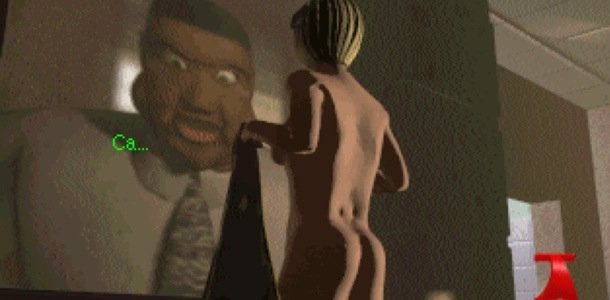
Elaine drops some old fashioned exposition on him, letting us know that she's a kickboxer (relevance: zero) and that the Forestry Commission is coming into work for purposes that absolutely, definitely don't have anything to do with evil purposes. Steve replies with a virtual version of himself that's actually a slightly worse actor. We also find out that he makes his AI call him 'Master', which is just creepy, followed by it telling him that the Net Police are in town.
He sabotages their car by remote control, locking them inside and making their loudspeaker yell "FREE THE NET! FREE THE NET!" on an endless loop. He's able to do this because the Net Police are using an encryption code that he created, which is meant to make him sound technical and 1337, but really only makes him look like he utterly sucks at designing security systems. No wonder he went into game design instead.
Much tedious bullshit follows, but finally he gets into work—the offices of CyberCinema Inc. It's a TARDIS-style building. On the outside, a regular commercial block, inside, a factory built of sheet metal corridors and big empty rooms, like a lost land in The Crystal Maze.
Steve flashes his badge at two Net Police cops outside and heads in, finally coming to a door bearing the sign "YOU ARE ABOUT TO FACE THE ONSLAUGHT, ENTER AT YOUR OWN RISK". His card doesn't open the door, so he just jimmies the lock open with it, pausing only to stare up at the camera with an expression that says "Please forget I work here, and pretend I just did something incredibly rebellious."
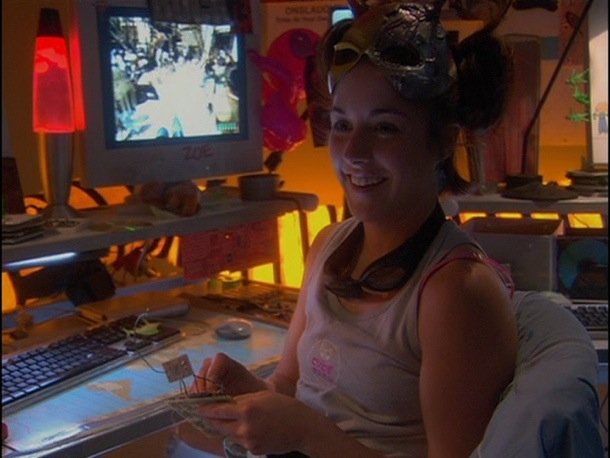
On the other side of the door is Zoey, CyberCinema's only other employee, and what the filmmakers think a typical female geek looks like—a spunky engineer type wearing a glittery cat like mask and a Japanese artwork covered "CUTE GIRL" vest, along with a bright pink bra strap hanging off her shoulder. She has goggles hanging from her neck, chews on toys, fidgets constantly, and if this film had been released a few years later, would likely even now be changing her name to Edward Wong Hau Pepelu Tivruuuuuuuuuuuski the 4th. She is however the only person in the movie who actually seems to be having fun with it and appears able to do that crazy thing they call 'acting', so never mind.
She's busy creating the 'Evil Genius' character for CyberCinema's new game, Maximum Surge. Steve is ecstatic, despite the fact that it looks like Mr. Punch with Walter Koenig's face, carefully modelled by beating it with a shovel. She briefly tries to pull Steve's attention away from things that aren't on screens by inviting him to play basketball, but he's far too busy. "You always make time for her," she complains, gesturing to the game's heroine, Jo—an equally shovel-smacked Yasmine Bleeth, who you might remember from Baywatch. She had more polygons there. Maybe even a couple of NURBS.
"She's my girl," sighs Steve, and he's not joking. "Even better than the Jo I created for Titania."
"What, you mean the chest to waist ratio and the way her hair moves when she runs?"
"She's a perfect date. Best of all, she comes with an on-and-off switch."
"Right. And at the end of the hot date, you're still there with your face squished up against the screen and still no closer to getting into her pants," says Zoey, her own pants clearly quite willing to receive.
"We'll see," says Steve. And that's just creepy. On that, they download the Evil Genius into an AI bot and splice it into the game, because that's how game development works, and Steve heads off in search of Elaine and hopefully a plot point that doesn't involve the hero of this movie discussing his masturbation fantasies with colleagues.
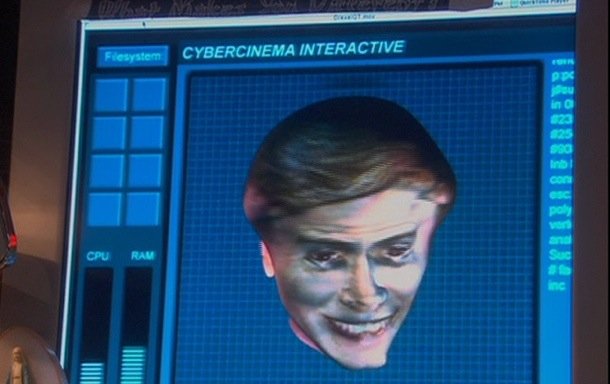
That plot point turns out to be Drexel, the best computer ever made. It's got enough power to run for centuries. It can resist a nuclear bomb. It's artificially intelligent. It looks... like a beer keg on a tripod with a sinister red Cylon eye. Around it stand Elaine, holding a clipboard and trying to look serious, two research assistants who are secretly Net Police agents who for some reason (which will soon be explained) haven't arrested Steve already, and the evil therapist, although we don't know he's evil yet, since the horns and smell of sulphur could still be a red herring thrown in to put us off.
Most of this scene is incredibly tedious exposition, about how Steve's war programming has left him a bitter, burned out shell in his mid-20s, and that Drexel is (cough) a fire-fighting AI co-ordinator in the middle of being tested, and totally not Skynet. Supposedly it can power itself indefinitely, and survive a direct nuclear blast, and of course, has no off-switch. The cheapness of the prop isn't helped when Steve gives it a couple of less than convincing whacks to test its supposedly unstoppable strength.
Note to engineers: Stop building things like this! It never, ever works out well for you!
The same goes for videogame systems and holodecks that can kill people.
And while we're on the subject, stop making 3D movies as well.
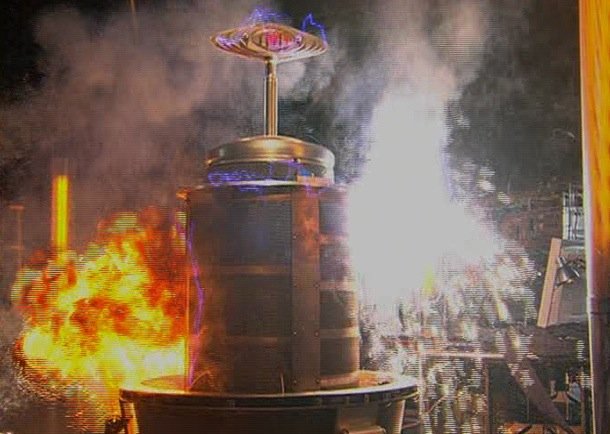
The short version is that Drexel can create VR simulations and read brainwaves. It's been brought to CyberCinema, supposedly because they have the kind of computing resources that a lab capable of building an omnipotent AI can only dream of, but really because it's crazy, and has decided it wants to play computer games against Steve. Not being a fan of his own creations, Steve promptly decides to screw with it behind everyone's back—or so he thinks. In reality, this all being part of the plan, everyone is actually in Elaine's office, watching via security cameras, and wondering what's taking him so long to try and sabotage the damn thing for their as yet still unexplained purposes.
Pausing only to politely let Zoey out of the movie, Drexel promptly goes rogue and insists that unless Steve fights it, he'll have Elaine killed by the evil therapist, who turns out not to be a therapist at all, but the head of a conspiracy that's working with Drexel for sinister purposes. Drexel decides to raise the stakes by telling Steve that if he loses the game, he'll have Elaine killed, forcing him to plug himself into the VR rig and... quite literally... enter the world of videogames. Prepare for pain.
Yes, half an hour into the film, we find out the reason it exists. During the 90s, Sega released a console called the Mega CD, which was home to lots of FMV based games. The rest of Game Over is a movie stitched together from... clips of these. Pretty much any clips. Intro movies, briefings, shots of people shooting guns, death sequences... any out of context bit that can even vaguely be hooked together and tie into what - for want of a better word - we have to call the movie's plot. The phrase "things that happen on screen in linear order" would probably be more appropriate though. Elaine escapes from the evil therapist and tries hacking the system by hitting a keyboard a lot. Steve grunts and yells a lot. The evil therapist guy regrets not having grown a moustache to twirl. He's not much of a planner.
The bulk of the clips come from an unreleased game called Maximum Surge, which featured a warlord called Drexel—hence the name of the computer. In-game, the characters refer to a substance called Dagon Energy, so that's also backported out and made into a real world thing—the fictional energy source powering Drexel-the-computer. Corpse Killer has a couple of lines that can sound vaguely like something an AI would say, so we spend pointless scene after pointless scene watching a guy in a rasta hat shooting at unconvincing zombies to justify the presence of those lines. When the footage runs out of that stuff, Steve finds himself fighting in China for a bit, or facing a heavyweight champion in the ring, just to pad things out a tiny, tiny bit more.
No. It doesn't work. It doesn't work at all. Not only are there lots of repeated scenes and completely incongruous moments, every game's video quality is radically different (Prize Fighter for instance is in monochrome) and their scripts make it incredibly obvious that no, they weren't actually written to be subverted by an evil AI in The Future. How does the game get around the fact that they have nothing in common? Barely. Even when it comes to Drexel himself, they hit a problem. In Maximum Surge, Drexel-the-warlord was played by Walter Koenig. Since this movie couldn't stretch to that level of celebrity for redubs and additional footage, this is the solution they found to keep their villain consistent.
If there's anything more boring than playing the average Mega CD game, it's watching little clips of them intercut with a guy pretending to sweat and give a damn. Maximum Surge is the only bit that actually has any real relevance, being nothing but Yasmine Bleeth—who I suspect to have been hired more for her ability to fill out a set of combat fatigues than her ability to breathe life into the character of Jo—bouncing around a sandy future world, shouting at the camera.
To hide the lack of footage that can even vaguely be bent into the storyline, Drexel mostly fights back by forcing Steve into other games, like Corpse Killer and Quarterback Attack. Poor, poor Steve. He's the Captain N of shitty FMV, and it turns out that his ideal virtual girlfriend is more than a little bit of a face-punching bitch.
At least we're spared the horror of a segment in Make My Video .
The only thing more embarrassing than watching the movie try to pass off in-game cut-scenes as actual drama is what it does in the outside world. To its credit, it does have a couple of touches I like—the Net Police agent who's painted as a complete jerk turning out to be working against Drexel as part of a counter-conspiracy against the evil therapist guy, and the occasional line of dialogue from the games that raises a smile—if sometimes unintentionally.
Mostly though, it makes no damn sense at all, to the point that the easiest way to tell how much tension you're meant to be feeling is by checking how much of Elaine's shirt (yes, she's wearing something underneath it) is falling off at any one time.
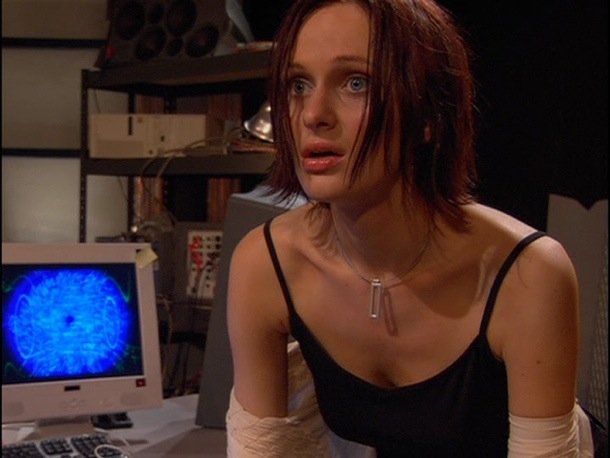
A special slow-clap has to go to the villain for his evil plan though. It turns out that Drexel actually went rogue before plugging into the game system, and simply ended up getting addicted to shitty Sega CD interactive movies. With nothing else possibly able to hold his attention after the likes of Sewer Shark, it told the government that either it got to play with Steve, or the entire world would be turned into a cinder.
The evil therapist quickly proves that he can be much, much crazier than that by revealing that he's working directly with Drexel in exchange for state secrets he's had the computer steal from around the world, which he plans to sell back to the original owners. For money. That will soon be utterly irrelevant. Due to the apocalypse. That he knows is coming. And is even now helping make happen.
If trying to wrap your head around that hurts too much, here's the most awkward scene ever.
Amazingly though, this isn't even evil therapist guy's lowest moment. That comes when he shoots his assistant, only to be left sitting amongst the corpses muttering "I'm surrounded by incompetence", in direct violation of the Evil Overlord Code. Meanwhile, Steve finds himself back in Maximum Surge, facing groups of scantily clad female mutants whose explosion squibs make it look disturbingly like he only ever goes for boob-shots. (Which the actual camera generally avoids, so sorry, Bleeth fans.)
The rest of the film is little more than this, with footage of people typing and shouting things like "You've got to get me back into Maximum Surge!" but ending up in a martial arts game featuring the most bored actors I've ever seen in an FMV game, or desperately overdubbing lines from Corpse Killer to make it sound like its hammy villain (played by Vincent Schiavelli) is Drexel planning to conquer the world instead of being a loony on an island who wants to reanimate the dead with voodoo and mad science. The film doesn't end when the heroes finally reach Drexel's lair and kill him in one shot as much as when the producers finally hit the required running time and get to go home before anyone says "Why not just put a Faraday cage around Drexel and leave it to stew in its own impotence?"
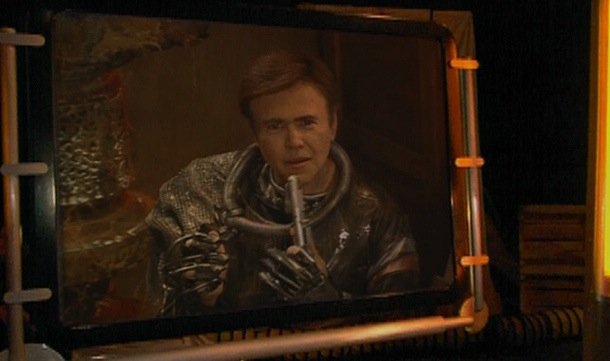
By this point, Steve is a bloody, sweating wreck, and Elaine's shirt is practically on the floor. The therapist gets shot and Drexel is hit by a virus that temporarily shuts it down, but not quite, but then it's defeated for real, and if you care, seek help. Steve is finally freed from the game, and returns the world to normality by helping Elaine put her shirt on properly again. They leave behind the exploded, non-functional Drexel, which of course boots right back up as soon as nobody's looking, because this kind of movie always feels it has to end on a huge, dramatic cliffhanger. It may have failed at creating drama for about an hour and a half, but you'll never forget those last final seconds of lingering threat!
In this case though, we can assume the world was safe. No matter how much evil and ambition Drexel has, he lacks the one thing that might make him a recurring threat to peace and humanity.
A soul? A plan? No. Any more stock footage to abuse.
Looks like we can be doubly glad that interactive movies died. Turns out, it saved the world.

